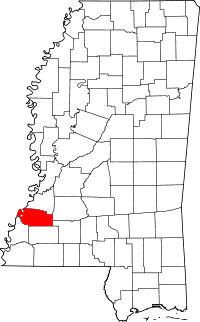Church Hill, Mississippi
| Church Hill, Mississippi | |
|---|---|
| Unincorporated community | |
 Church Hill, Mississippi  Church Hill, Mississippi | |
| Coordinates: 31°42′59″N 91°14′17″W / 31.71639°N 91.23806°WCoordinates: 31°42′59″N 91°14′17″W / 31.71639°N 91.23806°W | |
| Country | United States |
| State | Mississippi |
| County | Jefferson |
| Elevation | 213 ft (65 m) |
| Time zone | Central (CST) (UTC-6) |
| • Summer (DST) | CDT (UTC-5) |
| Area code(s) | 601 & 769 |
| GNIS feature ID | [1] |
Church Hill is a small unincorporated community in Jefferson County, Mississippi, United States. It is located on the bluffs of the Mississippi River, approximately 18 miles north of Natchez. The geographic features are different from those in the rest of the state; there are high and steep bluffs throughout. At the center intersection of this small community is an old wooden country store, with the old post office in it which was built around 1837. The store bears the name "Wagner's Grocery" on the upper header of the store. The store was closed in the late 1990s, after which it was donated to the Church Hill historic society for preservation. It is the oldest known all-wooden heart pine country store that had a post office in the southeastern United States.
Just across the intersection on a terraced hill is an old brick church, named Christ Church. It is the last of three successive buildings, and was completed in 1858. The church's design was copied from the old country churches in England. All the massive beams in the upper reaches of the church have been stained and false grained. The false graining was done by using turkey feathers. In the upper slave gallery on the farthest northeastern wall is a stained and feathered grained beam, on which is the writing with a turkey feather of the names of the builder and the grainer of the church. Around the community are a large number of privately owned antebellum homes. Church Hill was a thriving community at one time, the land and concomitant industries producing considerable wealth during the antebellum period.
Residents
Many prominent families resided in the area. For example, the Johnston family lived at Church Hill. James Steptoe Johnston (1843–1924) became the Second Bishop of West Texas (headquartered in San Antonio) and was the founder of the West Texas Military Academy (1893), Douglas MacArthur's alma mater (1897). WTMA is now called TMI: The Episcopal School of Texas. In 1861, Johnston was a student at the University of Virginia and volunteered for service contra President Lincoln's 75,000 troops mustered to march on Virginia. Johnston began the War with the 11th Mississippi Infantry and finished with a cavalry group. He saw 12 engagements in all until he was captured late in the war. At least one memorable and horrible battle with the 11th was on September 17, 1862 at Sharpsburg (Antietam). The 11th Mississippi was assigned to Hood's Brigade and participated in the famous Counterattack that left many of Johnston's fellows dead on the cornfield. The counterattack probably what gave General Lee a "draw" instead of a humiliating defeat, breaking the Federalist center, and the Confederates held the field. When Bishop Johnston became a prisoner of war, he was sent to an island in Lake Erie named for one of his ancestors who traded with the Indians in the 18th century: Johnston Island. Church Hill has the largest fresh butterbean and pea shelling operation in the United States.
-

In the center of Church Hill stands "Christ Church".
-

Wagner's Grocery was the unofficial city hall of this small town.
